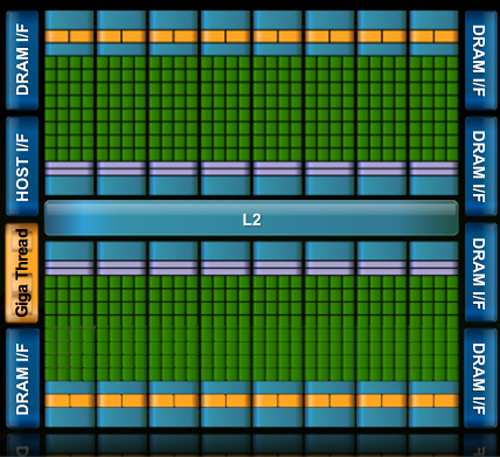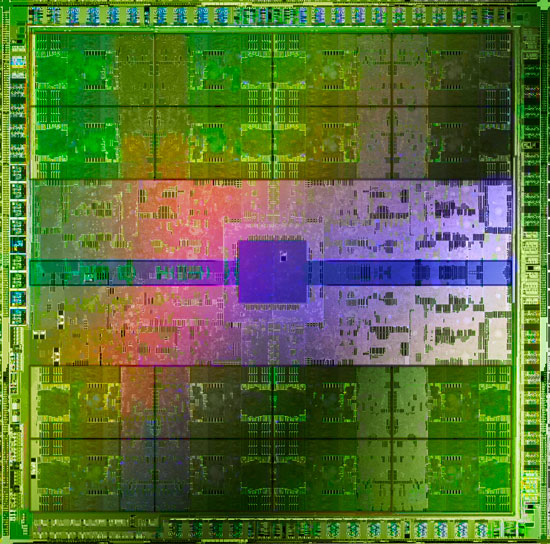At this year’s Consumer Electronics Show, NVIDIA had several things going on. In a public press conference they announced 3D Vision Surround and Tegra 2, while on the showfloor they had products o’plenty, including a GF100 setup showcasing 3D Vision Surround.
But if you’re here, then what you’re most interested in is what wasn’t talked about in public, and that was GF100. With the Fermi-based GF100 GPU finally in full production, NVIDIA was ready to talk to the press about the rest of GF100, and at the tail-end of CES we got our first look at GF100’s gaming abilities, along with a hands-on look at some unknown GF100 products in action. The message NVIDIA was trying to send: GF100 is going to be here soon, and it’s going to be fast.

Fermi/GF100 as announced in September of 2009
Before we get too far ahead of ourselves though, let’s talk about what we know and what we don’t know.
During CES, NVIDIA held deep dive sessions for the hardware press. At these deep dives, NVIDIA focused on 3 things: Discussing GF100’s architecture as is relevant for a gaming/consumer GPU, discussing their developer relations program (including the infamous Batman: Arkham Asylum anti-aliasing situation), and finally demonstrating GF100 in action on some games and some productivity applications.
Many of you have likely already seen the demos, as videos of what we saw have already been on YouTube for a few days now. What you haven’t seen and what we’ll be focusing on today, is what we’ve learned about GF100 as a gaming GPU. We now know everything about what makes GF100 tick, and we’re going to share it all with you.
With that said, while NVIDIA is showing off GF100, they aren’t showing off the final products. As such we can talk about the GPU, but we don’t know anything about the final cards. All of that will be announced at a later time – and no, we don’t know that either. In short, here’s what we still don’t know and will not be able to cover today:
- Die size
- What cards will be made from the GF100
- Clock speeds
- Power usage (we only know that it’s more than GT200)
- Pricing
- Performance
At this point the final products and pricing are going to heavily depend on what the final GF100 chips are like. The clockspeeds NVIDIA can get away with will determine power usage and performance, and by extension of that, pricing. Make no mistake though, NVIDIA is clearly aiming to be faster than AMD’s Radeon HD 5870, so form your expectations accordingly.
For performance in particular, we have seen one benchmark: Far Cry 2, running the Ranch Small demo, with NVIDIA running it on both their unnamed GF100 card and a GTX285. The GF100 card was faster (84fps vs. 50fps), but as Ranch Small is a semi-randomized benchmark (certain objects are in some runs and not others) and we’ve seen Far Cry 2 to be CPU-limited in other situations, we don’t put much faith in this specific benchmark. When it comes to performance, we’re content to wait until we can test GF100 cards ourselves.
With that out of the way, let’s get started on GF100.











115 Comments
View All Comments
FlyTexas - Monday, January 18, 2010 - link
I have a feeling that nVidia is taking the long road here...The past 6 months have been painful for nVidia, however I think they are looking way ahead. At its core, the 5000 series from AMD is really just a supersized 4000 series. Not a bad thing, but nothing new either (DX11 is nice, but that'll be awhile, and multiple monitors are still rare).
Games have all looked the same for years now. CPU and GPU power have gone WAY up in the past 5 years, but too much is still developed for DX9 (X360/PS3 partly to blame, as is Vista's poor adoption), and I suspect that even the 5000 series is really still designed around DX9 and games meant for it with a few "enhancements".
This new chip seems designed for DX11 and much higher detailed graphics. Polygon counts can go up with this, the number of new details can really shine, but only once games are designed from scratch for it. From that point, the 6 month wait isn't a big deal, it'll be another few years before games are really designed from scratch for DX11 ONLY. Otherwise you have DX9 games with a few "enhancements" that don't add to gameplay.
It seems like we are really skipping DX10 here, partly due to Vista's poor adoption, partly due to XP not being able to use DX10. With Windows 7 being a success and DX11 backported to Vista, I think in the next 2-3 years you'll finally see most games come out that really require Vista/7 because they will require DX10/11.
Of course, my 260GTX still runs everything I throw at it, so until games get more complex or something else changes, I see no reason to upgrade. I thought about a 5870 as an upgrade, but why? Everything already runs fast enough, what does it get me other than some headroom? If I was still on a 8800GT, it would make sense, but I'd rather wait for nVidia to launch so the prices come down.
PorscheRacer - Tuesday, January 19, 2010 - link
Well then there's the fact ATI designed their 2000 series (and 3000 and 4000 series) to comply with the full DirectX 10 specification. NVIDIA didn't have the chips required for this spec, and talked Microsoft into castrating DX10 by only adding in a few things. Tessellation was notably left out. ATI wsa hung out to dry on performanec and features wasted on die. They finalyl got DX10.1 later on but the damage was done.Sure people complained about Vista, mostly gamers as games ran slower, but I wonder how those games would have been if DX10 was run at the full spec (which was marginally lower the DX11 today)?
Scali - Wednesday, January 27, 2010 - link
I think you need to read this, and reconsider your statement:http://scalibq.spaces.live.com/blog/cns">http://scalibq.spaces.live.com/blog/cns!663AD9A4F9CB0661!194.entry
jimhsu - Monday, January 18, 2010 - link
I made this post in another forum, but I think it's relevant here:---
Yes, I'm beginning to see this [games becoming less GPU limited and more CPU limited] with more mainstream games (to repeat, Crysis is NOT a mainstream game). FLOP wise, a high end video card (i.e. 5970 at 5 TFLOP) is something like 100 TIMES the performance of a high end CPU (i7 at 50 GFLOPS).
In comparison, during the 2004 days, we had GPUs like the 6800 Ultra (54 GFLOP) and P4's (6 GFLOP) (historical data here: http://forum.beyond3d.com/showthread.php?t=51677)">http://forum.beyond3d.com/showthread.php?t=51677). That's 9X the performance. We've gone from 9X to 100X the performance in a matter of 5 years. No wonder few modern games are actually pushing modern GPUs (requiring people who want to "get the most" out of their high powered GPUs to go for multiple screens, insane AA/AF, insane detail settings, complex shaders, etc)
I know this is a horrible comparison, but still - it gives you an idea of the imbalance in performance. This kind of reminds me of the whole hard drive capacity vs. transfer rate argument. Today's 2 TB monsters are actually not much faster than the few GB drives at the turn of the millennium (and even less so latency wise).
Personally, I think the days of GPU bound (for mainstream discrete GPU computing) closed when Nvidia's 8 series launched (the 8800GTX is perhaps the longest-lived video card ever made). And in general, when the industry adopted programmable compute units (aka DirectX 10).
AznBoi36 - Tuesday, January 19, 2010 - link
Actually the Radeon 9700/9800 Pro had a pretty long life too. The 9700 Pro I bought in 2002/2003 had lasted me all the way to early 2007, which was when I then bought a 8800GTS 640mb. 4 years is pretty good. It could have lasted longer, but then I was itching for a new platform and needed to get a PCI-Express card (the Radeon was AGP).RJohnson - Monday, January 18, 2010 - link
Sorry you lost all credibility when you tried to spin this bullsh*#t "Today's 2 TB monsters are actually not much faster than the few GB drives at the turn of the millennium"Go try and run your new rig off one of those old drives, come back and post your results in 2 hours when your system finally boots.
jimhsu - Monday, January 18, 2010 - link
A fun chart. Note the performance disparity.http://i65.photobucket.com/albums/h204/killer-ra/V...">http://i65.photobucket.com/albums/h204/...Game%20S...
jimhsu - Monday, January 18, 2010 - link
Disclosure: I'm still on a 8800 GTS 512, and I am in no pressure to upgrade right now. While a 58xx would be nice to have, on a single monitor I really have no need to upgrade. I may look into going i7 though.dentatus - Monday, January 18, 2010 - link
If something works well for you then there is no real reason (or need) to upgrade.I still run an 8800 ultra, it still runs many games well on a 22 inch monitor. The GT200 was really only a 50% boost over the 8 series on average. For comparison, I bought a second hand ultra for $60, transplanted both of them into an i7 based system and this really produced a significant boost over a GTX285 in the games I liked; about 25% more performance- roughly equivalent to HD5850, albeit not always as smooth.
It would be good to upgrade to a single GPU that is more than double the performance of this kind of setup. But a HD5800 series card is not in that league, and it remains to be seen if the GF100 is.
dentatus - Monday, January 18, 2010 - link
I agree this chip does seem designed around new or upcoming features. Many architectural shortcomings from the GT200 chip seem to be addressed and worked around getting usable performance (like tesselation) for new API features.Anyway to be pragmatic about things, nvidias history leaves much to be desired; performance promised and performance delivered is very variable. HardOCP mentioned the 5800 Ultra launch as a con, there is also th G80 launch on the flip side.
A GPU's theoretical performance and the expectations hanging around it are nothing to make choices by, wait for the real proof. Anyone recall the launch of the 'monstrous' 2900XT? A toothless beast that one.